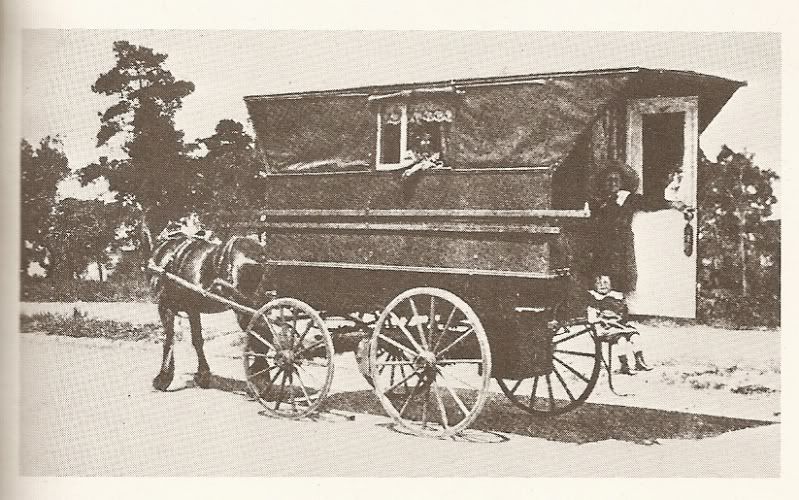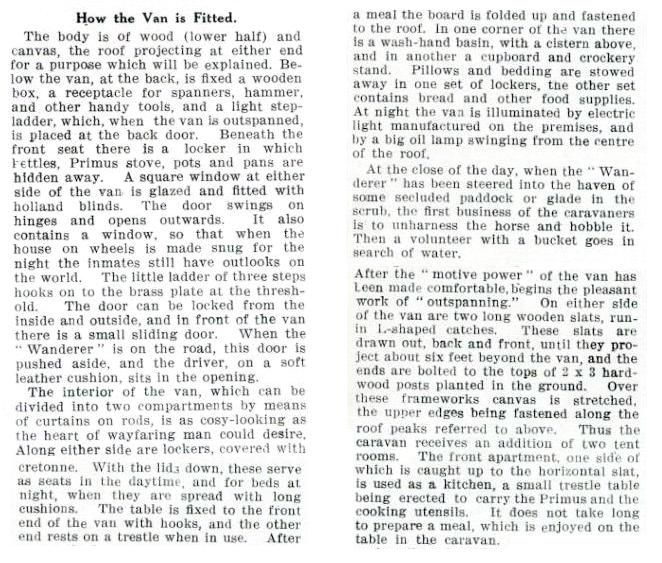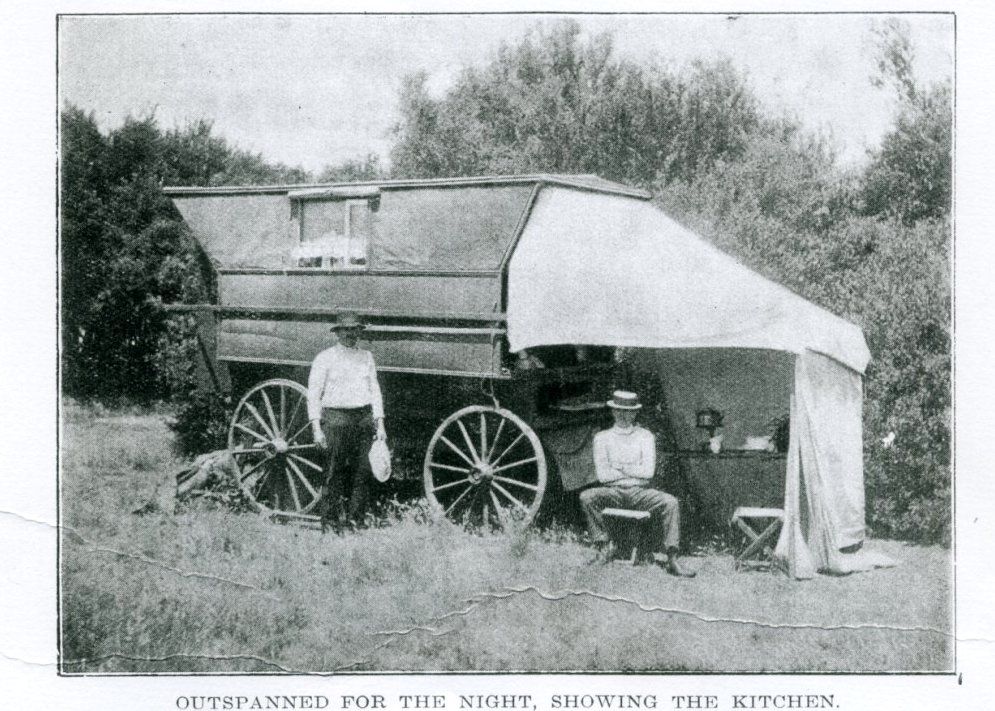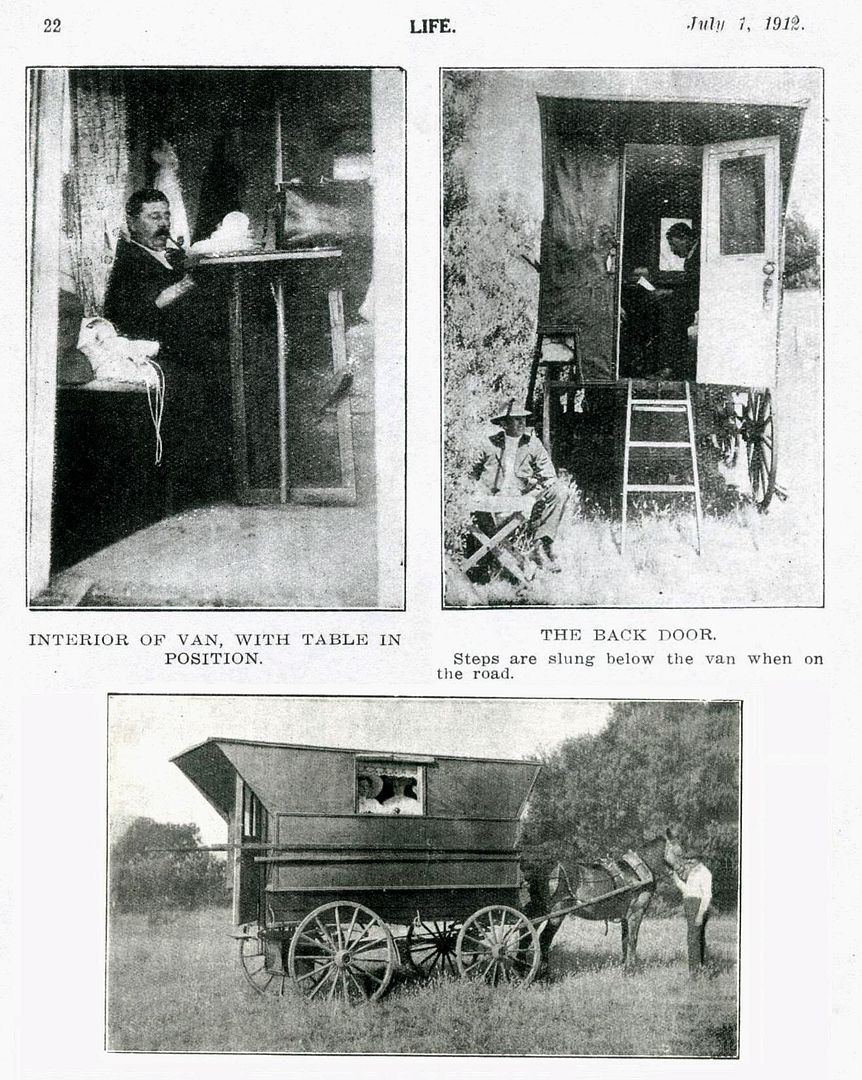|
|
Post by Don Ricardo on Apr 18, 2011 15:05:45 GMT 10
Hi all, Seeing there have been a few contributions lately to the thread on 1920's caravans, I thought it was about time someone started a thread on caravans built in the 1910's!    Below is a photograph of a 'holiday caravan' in use in Victoria in 1911. I wonder what the lengths of timber attached to the side are for?  ( From the La Trove Collection of the State Library of Victoria.Source: T & M Giltrap, Romance of Australian Transport, Rigby, 1981, p 75) [It reveals the depth of the V V affliction when you start buying a book - admittedly second hand - for one photograph! Ah, woe is me...    ;D ;D ;D ] ;D ;D ;D ] |
|
|
|
Post by bubbles on Apr 18, 2011 22:56:28 GMT 10
I bet the childs seat at the back is not up to australian standards of today. the two pieces of wood could be for holding up an awning of sorts , I notice the brakes are on just as well with all that horse power at the front
bubbles
|
|
|
|
Post by griffin on Dec 1, 2011 9:54:02 GMT 10
Don R I hope you haven't been holding your breath waiting for an answer to your question about the purpose of the timber on the sides of this caravan but 'Bubbles' was on the mark. While fishing around at the Mitchell Library in Sydney a while back I diverted my attention to caravans and found a reference in the cards to an article on caravanning in 1912. It was published in an Australian magazine titled 'Life' and consisted of several pages with photos of an identical caravan. The article was titled "The Open Road - The Joys of a Cruise in a Caravan" written by Charles Barrett. This extract from the article describes the use of the timber to erect what in vintage caravanning would be an annex, and today I guess it's one of those roll away awnings. It was referred to as 'outspanning' then. Marvellous what's in books. A Google of 'outspanning' sent it into a spin! George  |
|
|
|
Post by griffin on Dec 1, 2011 10:06:10 GMT 10
And, here's a photo of the caravan in the 'outspanned' position. I wonder who the caravan maker was, it appears to have more equal size wheels than the one in the original post but otherwise identical, even to the curtains. The lifestyle described in the article sounds really appealing, travelling at leisurely pace and taking in the countryside for all it is worth. It would never fit into todays rip, tear and bust pace. The author, Charles Barrett (1879-1959), was a very interesting character too, to me at least. He was a naturalist and journalist with 56 titles to his credit. As a youth, with an eye set on a career as a lepidopterist I owned and a well thumbed copy of his book “Butterflies of Australia and New Guinea” as I careened about the bush in search of prey. He also published articles on natural history in early issues of Australian Modern Motor Manual and was the author of Motor Manual’s Tourist Guide, ‘Highways of Australia’, 1st Edition, 1949-50. His biography says he was married in 1911 and I can’t help but wonder if one of the ladies at the lace trimmed caravan window was his wife. It also reveals he travelled about Australia extensively after WWI and I can’t imagine it wasn’t without some form of early caravan given his obvious love of the lifestyle in this article and his subsequent associations with Keith Winser. George  |
|
|
|
Post by cobber on Dec 1, 2011 14:35:53 GMT 10
Thanks for that one George.....you should have been a detective. And thanks for introducing us (me  ) to Charles Leslie Barrett. I looked him up in Wikipedia and The open Library web sites where I see he wrote a book called "Wanderer's rest". In that extract from the "Life magazine" article you gave us he refers to the van as the "Wanderer".... I got all excited and thought the book might be about Australia's "Wanderer" caravan, no such luck, you can pick the book up for between $4.68 and $40.06..... it's all about “An old drifter around the world, whose hobbies are book collecting and archaeology, and who delights in wild nature as well as in gardens, realises that his wandering years are over and settles down at "Wanderer's Rest" in a remote little Australian township” Could be his autobiography  Did you copy the whole article “The Open Road- The joys of a cruise in a Caravan”    Cobber. |
|
|
|
Post by griffin on Dec 1, 2011 16:06:58 GMT 10
Mmmmm, detective, that might have been a career move  "Wanderer's Rest" sounds like it may well have been his autobiography. Pity we can't all be as productive in our lifetime. The "Life" article was 4 pages plus a bit, which I missed. These are the other photographs from the article, fiddled onto one page for convenience. I'll email the full pages to you. George  |
|
|
|
Post by Don Ricardo on Dec 5, 2011 22:19:27 GMT 10
G'day Griffin, Thanks for posting the information you have discovered about Charles Barrett. It's fascinating to read about his caravan, and exciting to know that this story actually pushes Australia's caravan history back by a good decade and a half. Barrett seems to have been our version of Dr Gordon Stables, who is credited with starting the craze of "recreational caravanning" in England in 1886. As has been implied by your discussion with Cobber, I guess that Stables must have served as an inspiration for Barrett, since Stables' caravan was also called the "Wanderer". As I am sure you will have observed from your reading of the archives, newspapers in the 30's were full of comments from motoring writers who berated Australian motorists for not taking up caravanning. In fact Australians had been using caravans - on a limited basis admittedly - for several decades. Reading the articles in the 30's you would be forgiven for thinking that it was a completely new notion. Anyway, great posts!    Don Ricardo |
|
|
|
Post by Don Ricardo on Jan 20, 2012 20:01:57 GMT 10
Hi all, Following is an extract from a motoring article published in Adelaide newspaper The Register on 3 December 1919 (p 5). It is the earliest article (that I can remember) coming across in an Australian newspaper describing a "motor caravan". The caravan in question was on display at a car race in Indianapolis (the forerunner of the Indianapolis 500?).  (Source: National Library of Australia nla.gov.au/nla.news-article63123210 ) Note the following detail: "The rear was also equipped with a motor cycle used as a tender, and could be employed for special errands that would take the driver of the truck off the main line of travel." Another little bit of trivia is that later in the article there is a full list of the "latest registrations" of cars, "lorries" and motor cycles by the SA Registrar of Motor Vehicles. The list gives the registration number, owner and vehicle manufacturer. Just goes to show that car registration was still something newsworthy and worth reporting. You wouldn't find that today - too many privacy laws! Don Ricardo |
|
|
|
Post by shesgotthelook on Feb 1, 2012 15:21:00 GMT 10
Ooh, we have a settlers wagon on our place. This is what the early selectors lived in while establishing the farm & building a house for their famly who would join them later. I unfortunately can't photograph it as it is at the back of a house we rent out but will have a google for pics. A nearby farmers wife actually restores them.  |
|
|
|
Post by shesgotthelook on Feb 1, 2012 15:27:48 GMT 10
Nothing on Google. Only American Indian stuff  They were like slab huts on wheels & had a stove & a bed |
|